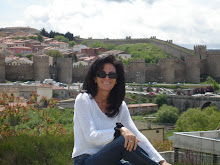skip to main |
skip to sidebar

Get in the back seat of the car and join us for a trip of a lifetime! Discover Europe as we drive for the next 4 months through the small back country road and discover hidden places.
Total Pageviews
WELCOME
TRAVEL ALONG!
Come on.. follow us on this exciting adventure - through the less traveled back roads of Europe! You will be amazed to discover the hidden treasures.
Enjoy and please post comments!
Jasmine and BobME!

- 2011 ROAD TRIP
- Spain
- I love love love traveling! So far I have visited over 73 countries and still counting. This blog was originally for a small group of family and friends. In such a short time it has grown tremendously from friends telling other friends. So Travel Along with us as we travel through the small back roads to visit the "less traveled" places. Have some fun while learning about the area, culture, food and personal tips to help turn your virtual travel into a reality.
Featured Video - NORWAY FJORDS
Blog Archive
-
▼
2011
(26)
-
▼
May
(12)
- #24 - M15 THE SPANISH REVOLUTION May 30 2011
- #23 - SLEEPING WITH AN EARTHQUAKE IN LORCA
- #22 - 2000 YEAR OLD DELICIOUS ORANGE
- #21 - "SUR LE PONT D'AVIGNON"
- #20 - FRENCH POODLES & A FACE LIFT
- #19 - OWN A FRENCH CHATEAUX FOR LITTLE MONEY!
- #18 - THE MAGIC KINGDOM
- #17 - RED-WHITE - or ROSE'?
- #16 - ADIOS or BONJOUR?
- DAY 15 - CATALONIA - GAY, HAPPY or BOTH?
- POP QUIZ 1 - Day 1-13 Review
- DAY 14 - VICKY, CRISTINA, BARCELONA
-
▼
May
(12)
Most Popular Posts
-
FRANCE DAY 20 To: Montepellier Climate: 23C - 75F Hottest day so far on the trip... Distance :...
-
CATALONIA Gay, Happy or Both? DAY 15 From: Barcelona - Spain To: Sitges & Girona - Spain Dist...
-
#26 JEREZ DE LA FRONTERA SPAIN From: Marbella To: Jerez Distance : 141km / 80 miles Time: ...
-
OWN A FRENCH CHATEAUX FOR LITTLE MONEY!! #19 FRANCE From: Carcassonne To: Montepellier Distance: 130km / 87...
-
THE MAGIC KINGDOM #18 To: Carcassonne - France Climate: 15C = 60F CARCASSONNE - The first time I eve...
Copyright 2011. Powered by Blogger.
Copyright © 2011 TRAVEL ALONG! | Powered by Blogger



 10:54 PM
10:54 PM
 2011 ROAD TRIP
2011 ROAD TRIP






1 comments:
Hey Guys, Now that was a real treat!!!! We haven't been to Agignon for about ten years and the memories were streaming. Your photography is superb! keep up the great work. Are you going on to Aix? Love, love, love that place. You're livin' the life. Laissez les bon temps roulez!!!! Woohoo!!! Ken & Terry
Post a Comment